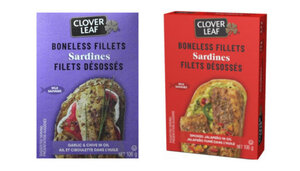
Botulism concerns spur recall of boneless sardines
By News Desk on January 23, 2021
Clover Leaf Seafoods Corp. is recalling two flavors of boneless sardines because it has been determined that they may permit the growth of Clostridium botulinum, which causes botulism poisoning.
The company triggered the recall, according to a notice posted by the Canadian Food Inspection Agency (CFIA). The notice did not provide any details on how the problem was discovered or how the volume of sardines subject to recall.
Government inspectors are working with the company to find the cause of the problem. The investigation could lead to the recall of other products, according to the CFIA notice.
As of the posting of the recall notice no confirmed illnesses had been reported in connection with the recalled sardines.
Consumers ca use the following label information to determine whether they have any of the recalled sardines in their homes.
| Brand | Product | Size | UPC | Codes |
|---|---|---|---|---|
| Clover Leaf | Sardines Boneless Fillets – Garlic & Chive in Oil | 106 g | 0 61362 46008 6 | 0170CBXP 2025 JN 18 0204CBXP 2025 JL 22 |
| Clover Leaf | Sardines Boneless Fillets – Smoked Jalapeño in Oil | 106 g | 0 61362 46009 3 | 0171CBXP 2025 JN 19 0218CBXP 2025 AU 05 0307CBXS 2025 NO 02 |
While a variety of illnesses can result from eating under-processed food, one of the most dangerous is botulism poisoning. Untreated, botulism can paralyze the muscles needed for breathing, resulting in sudden death.
Anyone who has eaten any recalled products and developed signs of botulism poisoning should immediately seek medical attention, according to the U.S. Centers for Disease Control and Prevention (CDC).
“In foodborne botulism, symptoms generally begin 18 to 36 hours after eating contaminated food. However, symptoms can begin as soon as 6 hours after or up to 10 days later,” according to the CDC website.
The symptoms of botulism may include some of all of the following: double vision, blurred vision, drooping eyelids, slurred speech, difficulty swallowing, difficulty breathing, a thick-feeling tongue, dry mouth, and muscle weakness. People with botulism poisoning may not show all of these symptoms at once.
These symptoms result from muscle paralysis caused by the toxin. If untreated, the disease may progress, and symptoms may worsen to cause paralysis of specific muscles, including those used in breathing and those in the arms, legs, and the body from the neck to the pelvis area.
(To sign up for a free subscription to Food Safety News, click here.)





